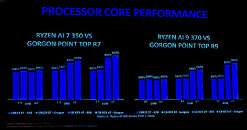
AMD Readies "Gorgon Point" Mobile Processor for 2026: Zen 5 + RDNA 3.5
AMD presented its next generation mobile processor that succeeds its current Ryzen AI 300 "Strix Point" to its industry partners. This presentation allegedly got leaked to the web. The 2026 successor to "Strix Point" is codenamed "Gorgon Point," and offers a significant single-threaded performance uplift while interestingly retaining the CPU core and iGPU IP. The slides mention "Gorgon Point" as combining up to 12 CPU cores based on "Zen 5" or "Zen 5c," an iGPU based on the RDNA 3.5 graphics architecture, and an NPU based on XDNA 2—so for the most part the IP is unchanged. The CPU, iGPU, and NPU, get performance upgrades over the current "Strix Point" chip.
AMD accompanied the specs slides with first party performance numbers. The multithreaded CPU performance numbers are moderately higher, which seem to indicate that the CPU core configuration of 4x "Zen 5" + 8x "Zen 5c" seems to be carried over; but the single-threaded performance sees a significant increase. We're not sure what's driving this, but there are two theories. The more obvious one is a significant increase in clock speeds, helped by an updated power management; but the second more radical theory is that AMD updated the "Zen 5" P-cores to have full fat 512-bit FP capabilities, similar to the "Zen 5" cores in "Fire Range" and "Strix Halo" processors. If you recall, the "Zen 5" cores in "Strix Point" have their FPUs limited to dual-pumped 256-bit paths to execute AVX512 instructions, a design choice probably driven by power considerations. The NPU throughput has been moderately increased to deliver over 55 AI TOPS, AMD enabled the full NPU performance across all tiers of Ryzen AI SKUs based on this chip. In all, "Gorgon Point" is to "Strix Point" what "Hawk Point" was to "Phoenix Point."
AMD accompanied the specs slides with first party performance numbers. The multithreaded CPU performance numbers are moderately higher, which seem to indicate that the CPU core configuration of 4x "Zen 5" + 8x "Zen 5c" seems to be carried over; but the single-threaded performance sees a significant increase. We're not sure what's driving this, but there are two theories. The more obvious one is a significant increase in clock speeds, helped by an updated power management; but the second more radical theory is that AMD updated the "Zen 5" P-cores to have full fat 512-bit FP capabilities, similar to the "Zen 5" cores in "Fire Range" and "Strix Halo" processors. If you recall, the "Zen 5" cores in "Strix Point" have their FPUs limited to dual-pumped 256-bit paths to execute AVX512 instructions, a design choice probably driven by power considerations. The NPU throughput has been moderately increased to deliver over 55 AI TOPS, AMD enabled the full NPU performance across all tiers of Ryzen AI SKUs based on this chip. In all, "Gorgon Point" is to "Strix Point" what "Hawk Point" was to "Phoenix Point."





























